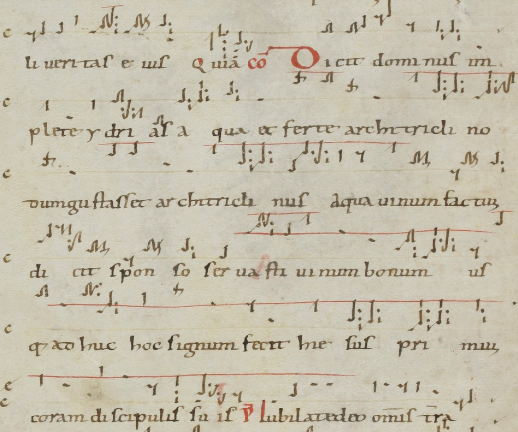Communio: Dicit Dominus
-
For the Communion chant "Dicit Dominus" (2nd Sunday after Epiphany/2nd Sunday in Ordinary Time) the books that provide psalm verses pair this mode VI chant with a mode V psalm tone. See Versus Psalmorum et Canticorum, p. 45, and Communio: Communion Antiphons and Psalm Verses (CMAA, ed. R. Rice), p. 50. Does anyone have insight into this curious situation?
And is there any connection between this special situation and the fact that some of the oldest manuscripts give the psalm verses in mode I (SG 381.63, SG 376.112)? -
Here is the reference to the Graduale Synopticum http://gregorianik.uni-regensburg.de/gr/#id/623
-
St. Yrieix shows a mode VI verse with a different text.


 Yrieix.jpg200 x 60 - 6K
Yrieix.jpg200 x 60 - 6K -
PS - Do you know of an index for the Versicularium, St. Gall 381?
-
Mode I and mode VI verse tones use the same dominant reciting note and are basically the same to answer your second question first.
The Dixit Dominus range extends from the third below the finalis (which is the thing that would make medieval theoreticians conclude this had to classified mode VI but only occurs on the words implete hydrias) to the seventh above. This top note which occurs three times would be a whole fifth above the dominant if considered to be mode VI and a third above the dominant if considered Mode V. Apart from the two words mentioned earlier all other phrases are above the finalis to put the antiphon in the range which is much more characteristic of mode V. That makes the mode V verse tone and reciting note a better match for the overall tessitura of this antiphon. I think this is a case of a musical impulse winning the argument over the theoretical analysis.Thanked by 1Andrew_Malton -
And the more of that, music over theory, the better, say I. Gregorian: sing it like it's music.
-
Perhaps the ambiguity surrounding the question of mode stems from the fact that the chant appears to have been intentionally composed not in a single mode but in three modes, one for each of the speakers of its text. The Evangelist narrates on la. The grave voice of the Lord utters His command on fa. And the ecstatic voice of the Architriclinus employs a dominant of either do, according to some manuscripts, or B-flat, according to others (see link to Graduale Synopticum posted above by tomjaw.)
So which modes are these? The Evangelist clearly sings in mode VI, reciting on la and cadencing to fa. The Lord appears to begin singing in mode II, reciting on fa, though he concludes with a mode VI-type cadence. What mode the Architriclinus is using would depend on which melodic version one follows. The Vatican Edition and the Graduale Novum go in different directions here. -
In the spirit of pursuing "music over theory," then, I would like to ask, what does the song of the Archtriclinus sound like to your ears? Does it sound like a mode V melody?
I'm not sure how I would classify it, if I had to. If we take the melodic version of the Vatican Edition, and accept the melodic correction of "bonus" proposed by the Graduale Synopticon -- listening to it, I could almost imagine it to be a mode IV melody transposed up a fifth.Thanked by 1tomjaw -
The critical apparatus for the Graduale Novum is attached, and also a MS for the Old Roman version of the chant, which isn't especially helpful for determining the real tonality of the Gregorian, although the psalm tone appears to be mode I.


 Co 6 Dicit Dominus.pdf109K
Co 6 Dicit Dominus.pdf109K
 Co Dicit Dominus implete.jpg518 x 432 - 408K
Co Dicit Dominus implete.jpg518 x 432 - 408K -
In terms of "overall tessitura" of the antiphon, mentioned by dhalkj above, a psalm tone in Mode I would certainly cover the bases as well, or even better, than a Mode V tone. As in those SG manuscripts.
Welcome to the MusicaSacra Forum!
To participate in the discussions on Catholic church music, sign in or register as a forum member, The forum is a project of the Church Music Association of America.
Categories
- All Discussions21,162
- General Music Discussion8,239
- Job Openings204
- Management of Music Programs850
- Choral Matters533
- Church Documents and Rubrics526
- CMAA Notes304
- Events720
- For Newcomers: Read First26
- Sacred Polyphony547
- Hymnody872
- Gregorian Chant: General2,703
- ↳ Graduale Romanum and Liber Usualis369
- ↳ Graduale Simplex60
- ↳ Semiology63
- Vernacular Plainsong696
- Anglican Use and Anglican Chant68
- Organ, Other Instruments and Repertoire435
- New Composition/Works in Progress1,295
- Recordings234
- Music for Hispanic Ministry159
- Music Education: Children211
- Music Education: General222
- News Items245
- Positions Wanted2
- General Discussion: Catholicism740
- Amusements177
- General Discussion1,035
- Opinions119

